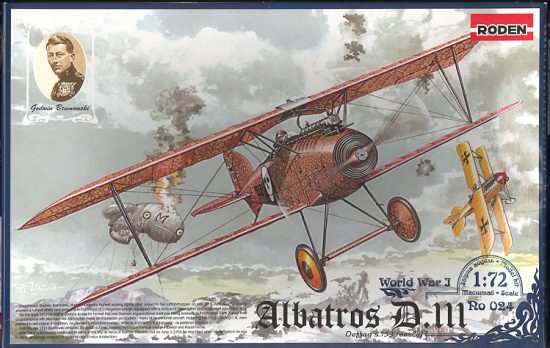
|
KIT: |
Roden 1/72 Oeffag S.153 (early) Albatross D.III |
|
KIT # |
0024 |
|
PRICE: |
$8.98 ($7.96 at Squadron) |
|
DECALS: |
21 aircraft (!) |
|
REVIEWER: |
|
|
NOTES: |

|
HISTORY |

As for the history and kit I will defer to the earlier kit preview.
Here we will take a short foray into the personality of Austria-Hungaryís Ace of Aces. His name was Godwin Brumowski. He was born in the village of Wadowice, Galicia, in present day Poland. He was not the only famous individual that this small village was to produce, as it was also the birthplace of Pope John Paul II. Godwin came from a military family, which allowed him to attend the Technical Academy in Molding, near Vienna. The Austro-Hungarian Empire was very class conscious, even more then Great Briton or Germany was, so the fact that he had a military background allowed him to graduate as a Leutnent (Second lieutenant).
Like Baron Manfred von Richtofen, he didnít start out as aviator. Godwin began his career as an artillery officer in Field Artillery Regiment No.29. When war broke out he was the Regimental Adjutant for the 6th Artillery Division and first saw action on the Russian front. Here he was awarded several medals for Bravery.
Like the Red Baron he saw aerial
combat for the first time, not as a fighter pilot but as a crewman in a two
seater. It is important to note here, that at this time, Gentlemen did not
drive their own cars nor did they fly their own aircraft. It was as an observer
that Godwin achieved his first aerial victory. On 12 April 1916 he and his
pilot Otto Jindra and six other aircraft, bombed a parade and review that was
being held for Tzar Nicholas II. Seven Morane-Saulnier L
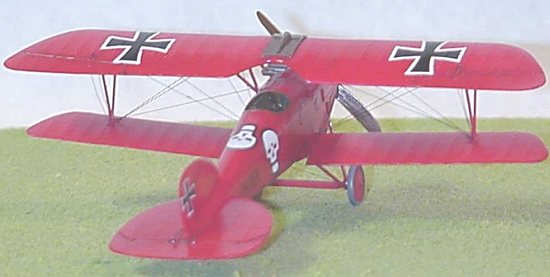 Parasols were scrambled to
intercept the insulting Austro-Hungarians and as a parting slap Godwin shot two
of them down. Both of the Russian pilots were wounded in the subsequent
crashes. He was by now considered the best observer on the Russian front. He
achieved one more victory before he became a pilot himself. After his fighter
training he was attached to Flik 12 on the Italian front where he got his fourth
victory.
Parasols were scrambled to
intercept the insulting Austro-Hungarians and as a parting slap Godwin shot two
of them down. Both of the Russian pilots were wounded in the subsequent
crashes. He was by now considered the best observer on the Russian front. He
achieved one more victory before he became a pilot himself. After his fighter
training he was attached to Flik 12 on the Italian front where he got his fourth
victory.
When the LFT decided to organize a pure fighter unit (Flik 41j) it was only logical to make Godwin the Commander. But first he would spend eight days with German Justa 24 where he would fly four combat missions and learn first hand all he could about German organization and fighter tactics. He also met one of Germanys rising stars, Manfred von Richthofen. He was very impressed with the Baron and they found much in common.
The pilots of Flik 41j reads like a who is who of Austro-Hungarian Aces. Over 20 percent of all Austro-Hungarian aces came through this unit at one time or another. Godwin is also responsible for some of the first camouflaged Austro-Hungarian aircraft. He started by painting his Phonix-built Hansa-Brandenburg D.I. The wings were painted green and yellow or mustard swirls were painted on top. Some even say that this paint scheme is what the later Austro-Hungarian Sworl printed fabric is based on. The green and yellow camouflage was very common on the aircraft of Flik 41J.
In late 1917 Godwin began to paint his aircraft red with white skulls, sometimes cloaked in black, on them. It is not quite known why the change, since his earlier aircraft were not so garishly painted nor did they have the skulls. His earlier aircraft were usually the green and yellow or left in the original factory finish with a geometric pattern painted on the side.
Godwin survived the war. However the defeat and subsequence brake up of the Empire was hard on him. He loved the fame and adoration that a man like him received. Suddenly there was nothing. He tried to be a farmer and manage his wifeís large family estate. He had no education as a farmer and failed at this venture. This was a hard blow for someone who had, up till now been successful at all he did.
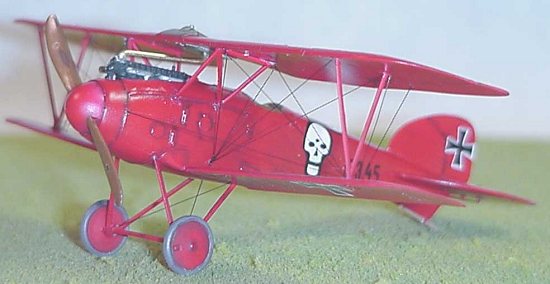 Godwinís daughter said of her
father. ĒHis surplus energy combined with his intense love of life drove him to
all kinds of activities which people around him could not understand. He hunted
restlessly in the mountains. He rode horses to exhaustion. He raced his
automobiles to shambles on the bad roads. He was the first into a burning house
and the last one out of it. He jumped into rivers during floods to rescue
animals. He loved parties and entertained his friends with his very good piano
playing. He was an excellent swimmer, ice skater, dancer, etc. There was almost
nothing my father could not do if he wanted to, only as the manager of the
estate he was a disaster. He finally left, probably because he could not stand
it any moreĒ
Godwinís daughter said of her
father. ĒHis surplus energy combined with his intense love of life drove him to
all kinds of activities which people around him could not understand. He hunted
restlessly in the mountains. He rode horses to exhaustion. He raced his
automobiles to shambles on the bad roads. He was the first into a burning house
and the last one out of it. He jumped into rivers during floods to rescue
animals. He loved parties and entertained his friends with his very good piano
playing. He was an excellent swimmer, ice skater, dancer, etc. There was almost
nothing my father could not do if he wanted to, only as the manager of the
estate he was a disaster. He finally left, probably because he could not stand
it any moreĒ
He moved to Vienna and started a flying school in Aspern. It is said that he was happy again and back in his own element. On 3 June 1936 he was mortally injured in a plane crash near Amsterdam.
His daughter later wrote. ďHe died relatively young and this was perhaps the way he wanted it. I can still remember him saying, ĎI will never become an old idiot.í I think he despised weaknesses, imperfections, stupidity, and even old age. He was a very unique and interesting person either very much liked, or hated, and even considered crazy by many.Ē
There you have it; He was the ace of aces for the Austro-Hungarian Empire with thirty-five confirmed victories. Sometimes called the Red Baron of the Austro-Hungarian Empire. The similarities between Godwin Brumowski and Manfred von Richthofen are quite intriguing.
|
THE KIT |
Please visit the earlier preview to see what's in the box.
|
CONSTRUCTION |
Well, as you who have read my articles in
the past will know, I do like the RODEN and TOKO kits very much and find that I
build lots of them. So I am quite acquainted with the good and not so good
aspects of them. In my opinion if you could find one thing about the Rodan
albatros kits that could be called annoying, is the upper wing is in three
parts. This was done to give the modeler the whole series of Albatros Fighters
while keeping the costs down. In other words the Albatros fighters had three
different center sections for their upper wings. This was due to the type and
placement of the radiator. You have to decide which type or series you want to
build. Then, these sections have to be glued together and set aside to dry.
Iíve not had any of them fit perfectly so a little sanding and filling putty is
in order here. Also take care in sanding the seams
 because the wing detail is
fine and you can quickly over sand the ribs around the joints so you would get
an obvious divot that can be seen from a distance.
because the wing detail is
fine and you can quickly over sand the ribs around the joints so you would get
an obvious divot that can be seen from a distance.
The work on this kit was divided in to two parts. First I started by working on the wings. From past experience I have found that it takes a while to build the upper wings so I began here. There is some flash on the parts so I lightly cleaned them and spent some time cleaning the joints for the three wing parts. I glued them and set them aside for a few days to dry. This is important because the joints are not the strongest, they just butt up against each other. After I let the wing thoroughly dry I used a sanding stick and putty to clean up the seams.
The engine for this kit was nice with good detail. The cockpit is nice with internal details molded in to the sides of the fuselage also the control column and rudder peddles are nice. The Austro-Hungarian Albatros fighters had a rudimentary instrument panel and you could see the breaches of the buried Schwarslose machine guns from the cockpit cut out. So, there is room for the builder to buy an after market detail set or if brave, to scratch the additional detail.
The fuselage went together pretty well. The kit has a lot of flash, not large areas of flash but little almost imperceptible areas on the joints. This translates in to somewhat rough joints. So a little time needs to be invested in making the joints fit tightly.
After all the components were assembled to a point, I painted the kit then applied the decals. I then finished the assembly and rigged it. I drill all the holes to accept the rigging. I use a through the wing method and 2 pound fishing line.
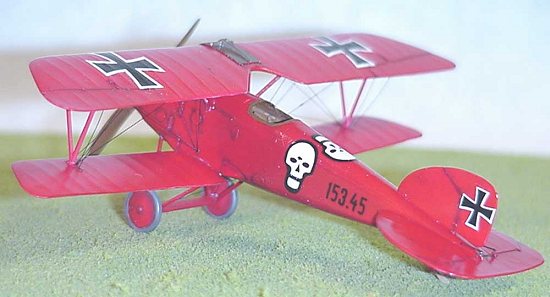 I super glue the rigging to
the upper wing and thread it through the bottom wing. I use fishing weights
(the clamp on variety) to tension the lines. I use a drop of glue to fix the
line in place. After a second you can cut them flush with the wing. I use a
little touch up paint and then put on the under wing decals. This helps cover
any marks made when rigging. Rigging takes me about an hour and the good thing
about this method is that it adds a tremendous amount of strength to the kit. I
use the same size of weights for all the lines. This is important because if
all the lines are tensioned the same you will not have warping problems. This
is not as important on injection molded kits but is very important when you are
building vac-u-form or resin kits. Sometimes you will get a resin kit that has
a warped wing and it will be very stubborn, even after you straighten it, it
will warp. If you have the rigging tensioned correctly that stubborn wing will
stay put.
I super glue the rigging to
the upper wing and thread it through the bottom wing. I use fishing weights
(the clamp on variety) to tension the lines. I use a drop of glue to fix the
line in place. After a second you can cut them flush with the wing. I use a
little touch up paint and then put on the under wing decals. This helps cover
any marks made when rigging. Rigging takes me about an hour and the good thing
about this method is that it adds a tremendous amount of strength to the kit. I
use the same size of weights for all the lines. This is important because if
all the lines are tensioned the same you will not have warping problems. This
is not as important on injection molded kits but is very important when you are
building vac-u-form or resin kits. Sometimes you will get a resin kit that has
a warped wing and it will be very stubborn, even after you straighten it, it
will warp. If you have the rigging tensioned correctly that stubborn wing will
stay put.
|
CAMO & MARKINGS |
Godwin Brumowski flew many
different types of aircraft and few were in factory finish. I decided to build
aircraft 153.45. In this aircraft he was credited with eight of his thirty-five
confirmed victories. Albatros D.III (Oef) 153.45 was his most successful
Albatros fighter. He almost met his demise in this aircraft also when on 1
February 1918, while fighting seven or eight enemy aircraft his aircraft was hit
by no less than twenty-six bullets. One punctured his fuel tank and started a
fire that quickly set the center section of the upper wing and the inboard lower
right wing on fire. He made for his
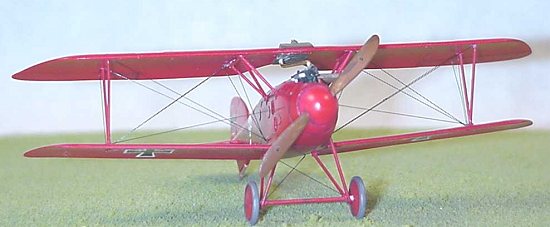 aerodrome and was able to land
with out further incident. Only four days later he was engaged by eight more
British fighters while flying Albatros D.III (Oef) 153.52. He barely got that
aircraft on the ground, it over turned on landing and was written off.
aerodrome and was able to land
with out further incident. Only four days later he was engaged by eight more
British fighters while flying Albatros D.III (Oef) 153.52. He barely got that
aircraft on the ground, it over turned on landing and was written off.
Like all Roden decals that Iíve worked with, they are thick and very stiff, they just donít conform to the kit surface very well. They will also silver quite easily. To make things worse Iíve not been able to find a decal solvent that will soften them, trust me Iíve tried everything but gasoline and a match to soften them. If someone has found something that will soften them so they will conform to the model a little better please tell me. The only thing that has worked for me is to apply them to a very glossy surface. I used the kit decals. As you can see they do work. Just donít get upset if they donít work the same as the decals that youíve used in the past.
|
CONCLUSIONS |
I like these kits and I am very glad to see Roden manufacturing this line of Albatros kits. As far as I know no one has ever produced such a complete series of the Albatros family of fighters. I am told that they will finish out their series with a D.V, D.Va and a W.4 early and late. That will give the model builder the opportunity to build all of the Albatros fighters that were in service without any special conversion kits or modifications.
In short, I donít think that there is a more accurate Albatros D.III Oeffag on the market. Eduard makes a 1/72 scale Albatros D.V/Va kit that is the easiest and I would say the best all a round Albatros kit to build.
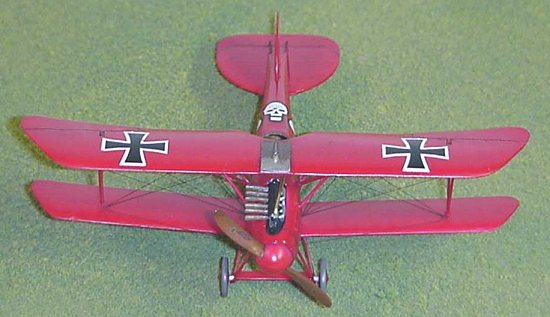 Roden has paid attention to
details that others have overlooked. Like the under-camber of the wings, Rodan
is the only company to get it correct in any scale. Also the control horns on
the ailerons are molded in the kit. Pegasus is the only other company to mold
this part. This discrepancy is puzzling since it is very prominent in most all
pictures of Albatros aircraft.
Roden has paid attention to
details that others have overlooked. Like the under-camber of the wings, Rodan
is the only company to get it correct in any scale. Also the control horns on
the ailerons are molded in the kit. Pegasus is the only other company to mold
this part. This discrepancy is puzzling since it is very prominent in most all
pictures of Albatros aircraft.
Keep an eye on Roden. I think that this will be the company to watch when it comes to 1/72 scale WWI kits. The kits take some work but have all the raw components to build a very nice kit. I would put them between Pegasus and Eduard kits for difficulty and would say that Roden is slightly better then both for accuracy. The most difficult aspect of the build was the upper wing and the decals. None of these things are really different from any other kits that you might build and didnít pose any real problems. However if Rodan could do two things to make their kits better it would be to make the upper wing in one piece. The next thing would be to use decals that would contour a little better and respond to decal solvents.
A= The best, easiest and most accurate
F= The worst, most difficult and inaccurate.
Accuracy B+ It scales out quite well
Fit B- Wing three part construction is problematic, flash
Ease of construction B- Because of the three-part wing construction is problematic and the flash
Aircraft options A 22 options!!!!!!!!!!
Decal quality C+ Very difficult to work with and solvents donít work on them
Instructions B+ Very good, however a rigging diagram is missing
This is a great kit and I will be building more of them. In fact I will be building the whole series. I would recommend this kit to anyone with moderate experience. The problems that are confronted are similar to what you would see on other kits. If you have a few biplanes under your belt this kit would help you stretch your skill level. If the upper wings were one piece and the decals easier to work with, I would recommend it as a first WWI kit.
December 2002
|
REFERENCES |
Austro-Hungarian Army Aircraft of World War One by Peter M. Grosz, George Haddow and Peter Schiemer (Very Highly Recommended)
Air Aces of the Austro-Hungarian Empire 1914-1918 by Dr. Martin OíConner (Very Highly Recommended)
Austro-Hungarian Aces of World War 1 by Christopher Chant (The first two books are on the expensive side, if you are on a budget this book would be a good choice.)
Osprey Aircraft of the Aces #46
Albatros Fighters in action Squadron/signal publications No.46
Albatros (OEF) D.III Albatros Publications No.19
You can find this kit and many others at

If you would like your product reviewed fairly and quickly by a site that has well over 175,000 visitors a month, please contact me or see other details in the Note to Contributors.
Back to the Reviews Index Page